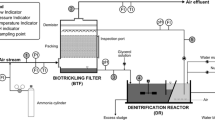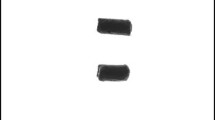Abstract
Excess biomass buildup in biotrickling filters leads to low performance. The effect of biomass accumulation in a biotrickling filter (BTF) packed with polyurethane foam (PUF) was assessed in terms of hydrodynamics and void space availability in a system treating dimethyl disulfide (DMDS) vapors with an alkaliphilic consortium. A sample of colonized support from a BTF having been operating for over a year was analyzed, and it was found that the BTF void bed fraction was reduced to almost half of that calculated initially without biomass. Liquid flow through the examined BTF yielded dispersion coefficient values of 0.30 and 0.72 m2 h−1, for clean or colonized PUF, respectively. 3D images of attached biomass obtained with magnetic resonance imaging allowed to calculate the superficial area and the biofilm volume percentage and depth as 650 m2 m−3, 35 %, and 0.6 mm respectively. A simplified geometric approximation of the complex PUF structure was proposed using an orthogonal 3D mesh that predicted 600 m2 m−3 for the same biomass content. With this simplified model, it is suggested that the optimum biomass content would be around 20 % of bed volume. The activity of the microorganisms was evaluated by respirometry and the kinetics represented with a Haldane equation type. Experimentally determined parameters were used in a mathematical model to simulate the DMDS elimination capacity (EC), and better description was found when the removal experimental data were matched with a model including liquid axial dispersion in contrast to an ideal plug flow model.









Similar content being viewed by others
References
Alonso C, Suidan MT, Sorial GA, Smith FL (1996) Gas treatment in trickle-bed biofilters: Biomass, how much is enough? Biotechnol Bioeng 54(6):583–594
Alonso C, Suidan MT, Kim BR, Kim BJ (1998) Dynamic mathematical model for the biodegradation of VOCs in a biofilter: Biomass accumulation study. Environ Sci Technol 32:3118–3123
Arellano-García L, González-Sánchez A, Van Langenhove H, Kumar A, Revah S (2012) Removal of odorant dimethyl disulfide under alkaline and neutral conditions in biotrickling filters. Water Sci and Technol 66(8):1641–1646
Bonilla WC (2013) Uso de respirometrías heterogéneas para estimar coeficientes de transferencia de masa interfaciales y parámetros biocinéticos en biofiltros de lecho escurrido. Dissertation, UAM Iztapalapa, Mexico
De Beer D, Stoodley P (2006) Microbial biofilms. In: Dwarkin E, Falkow S, Rosenberg E, Schleifer KH, Stackebrandt E (eds) The prokaryotes, 3rd edn. Springer, New York, pp 904–937
Delgado JMPQ (2006) A critical review of dispersion in packed beds. Heat Mass Transfer 42(4):279–310
Deshusses MA, Cox HHJ, Miller DW (1998) The use of CAT scanning to characterize bioreactors for waste air treatment. Paper 98-TA20B.04. In: Proceedings Annual Meeting and Exhibition of the Air and Waste Management Association, San Diego, CA, USA
Dorado AD, Lafuente J, Gabriel D, Gamisans X (2012) Biomass accumulation in a biofilter treating toluene at high loads. Part 2: Model development, calibration and validation. Chem Eng J 209:
Estrada JM, Kraakman NJR, Lebrero R, Munoz R (2012) A sensitivity analysis of process design parameters, commodity prices and robustness on the economics of odour abatement technologies. Biotechnol Adv 30:1354–1363
Gianetto A, Specchia V (1992) Trickle-bed reactors: State of art and perspectives. Chem Eng Sci 47(13):3197–3213
González-Sánchez A, Revah S, Deshusses MA (2008) Alkaline biofiltration of H2S odors. Environ Sci Technol 42:7398–7404
Granada C, Revah S, Le Borgne S (2009) Diversity of culturable bacteria in an alkaliphilic sulfur-oxidizing microbial consortium. Adv Mat Res 71:137–140
Herskowitz M, Smith JM (1983) Trickle bed reactors: a review. AICHE J 29(1):1–18
Iliuta I, Bildea SC, Iliuta MC, Larachi F (2002) Analysis of trickle bed and packed bubble column bioreactors for combined carbon oxidation and nitrification. Braz J Chem Eng 19(1):69–88
Integrated Computer Aided System (ICAS), Educational Version. Computer Aided Process Engineering Center. Technical University of Denmark
Jiménez B, Noyola A, Capdeville B (1988) Selected dyes for residence time distribution evaluation in bioreactors. Biotechnol Tech 2(2):77–82
Kim S, Deshusses MA (2003) Development and experimental validation of a conceptual model for biotrickling filtration of H2S. Environ Prog 22(2):119–128
Kim S, Deshusses MA (2005) Understanding the limits of H2S degrading biotrickling filters using a differential biotrickling filter. Chem Eng J 113(2):119–126
Levenspiel O (1998) Chemical reaction engineering. John Wiley & Sons, New York
Lewandowski Z, Stoodley P, Altobelli S (1995) Experimental and conceptual studies on mass transport in biofilms. Wat Sci Tech 31(1):153–162
Neu TR, Manz B, Volke F, Dynes JJ, Hitchcock AP, Lawrence JR (2010) Advanced imaging techniques for assessment of structure, composition and function in biofilm systems. FEMS Microbiol Ecol 72(1):1–21
Picioreanu C, van Loosdrecht MCM, Heijnen JJ (2000) A theoretical study on the effect of surface roughness on mass transport and transformation in biofilms. Biotechnol Bioeng 68(4):355–369
Ramírez M, Fernández M, Granada C, Le Borgne S, Gómez JM, Cantero D (2011) Biofiltration of reduced sulphur compounds and community analysis of sulphur-oxidizing bacteria. Bioresource Technol 102:4047–4053
Sharvelle S, McLamore E, Banks MK (2008a) Hydrodynamic characteristics in biotrickling filters as affected by packing material and hydraulic loading rate. J Environ Eng-ASCE 134:346–352
Sharvelle S, Arabi M, McLamore E, Banks MK (2008b) Model development for biotrickling filter treatment of graywater stimulant and waste gas. I J Environ Eng-ASCE 134:813–825
Silva J, Morales M, Cáceres M, Morales P, Aroca G (2012) Modelling of the biofiltration of reduced sulphur compounds through biotrickling filters connected in series: Effect of H2S. Electron J Biotechn 15(3):1–15
Smet E, Van Langenhove H (1998) Abatement of volatile organic sulfur compounds in odorous emissions from the bio-industry. Biodegradation 9:273–284
Smith N, Kelly DP (1988) Isolation and physiological characterization of autotrophic sulphur bacteria oxidizing dimethyl disulphide as sole source of energy. J Gen Microbiol 134:1407–1417
Standard Methods for the Examination of Water and Wastewater (1998) 20th edn, American Public Health Association/American Water Works Association/Water Environment Federation, Washington, DC, USA
Trejo-Aguilar G, Revah S, Lobo R (2005) Hydrodynamic characterization of a trickle bed air biofilter. Chem Eng J 113:145–152
Wan S, Li G, An T, Guo B (2011) Co-treatment of single, binary and ternary mixture gas of ethanethiol, dimethyl disulfide and thioanisole in a biotrickling filter seeded with Lysinibacillus sphaericus RG-1. J Hazard Mater 186:1050–1057
Zarook SM, Shaikh AA, Azam SM (1998) Axial dispersion in biofilters. Biochem Eng J 1(1):77–84
Acknowledgements
The authors would like to thank Conacyt for financing this project (I0017-166451) and the scholarship of LAG. To AECID for granting the funds for LAG internship in the UPC-Barcelona through project A2/037075/11. And to Rafael Lara and the Ci3M center for MRI analysis.
Author information
Authors and Affiliations
Corresponding author
Electronic supplementary material
Rights and permissions
About this article
Cite this article
Arellano-García, L., Dorado, A.D., Morales-Guadarrama, A. et al. Modeling the effects of biomass accumulation on the performance of a biotrickling filter packed with PUF support for the alkaline biotreatment of dimethyl disulfide vapors in air. Appl Microbiol Biotechnol 99, 97–107 (2015). https://doi.org/10.1007/s00253-014-5929-7
Received:
Revised:
Accepted:
Published:
Issue Date:
DOI: https://doi.org/10.1007/s00253-014-5929-7




